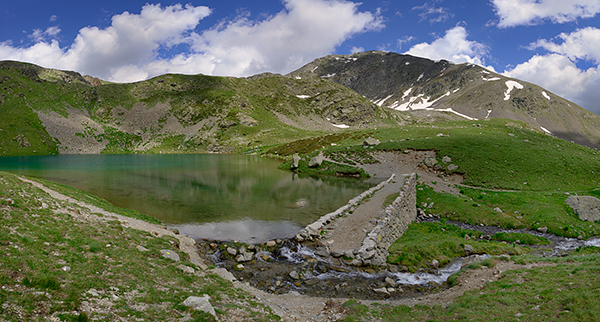Mercantour National Park France (Part One)
Mercantour National Park, France
Mercantour is one of France’s 10 National Parks and situated north of Nice in Provence. It is perhaps one of the lesser-known parks, but in terms of wildlife, it is extremely rich with a network of walks and stunning mountain scenery, which makes it an ideal place to visit.
The national park is only an hour’s drive from Nice, yet it’s another world. The stunning mountain streams and lakes are set among 3000m-high valleys and mountains with villages embedded among the cliff tops.
Running a workshop in a location such as this provides a rich variety of subject material, which kept us busy every day. We spent long hours in the field – often until 9pm weather permitting. The road system is perhaps not the best and sometimes required lengthy drives to reach certain locations, which as the crow flies, were reasonably close. The insects were rich and varied; orchids were often common on the roadside verges – and frequently in large numbers. Many of the sites were rich in butterflies and we often spent many hours targeting certain species.
The weather was challenging at times with soaring high temperatures making insect photography challenging – we ended up doing most of it, either early in the morning, or late in the evening. There was also a serious shortage of restaurants and service stations, which meant we often had to drive 20km to refuel before we even started our journey that day, but it was a small price to pay considering the beauty of the place.
For anyone contemplating a trip to this region would need to take these issues into consideration when planning a trip. Having a package with one of the few hotels in the region would be the best plan, in my opinion.
Throughout the 10 days, we managed to produce some really splendid images. Below is a small sample of quickly processed images from the Rimplas area, which was our base. I will be writing up a full account for publication in the not too distant future!

Apollo Parnassius apollo
We saw quite a number of Apollo’s which were common at some of the sites we visited. Above are a pair in cop which was a real bonus!
Nikon D800, 200mm macro lens, ISO 200 @ f/11, Fill-flash, tripod.

Apollo Parnassius apollo
A different angle of a resting adult in an upland meadow in early evening.
Nikon D800, 200mm macro lens, ISO 200 @ f/8, Fill-flash, tripod.

Apollo Parnassius apollo
These are pretty large insects and fairly easy to approach with a longer lens. When the sun disappears they quickly drop into the foliage and will happily sit there until it reappears.
Nikon D800, 200mm macro lens, ISO 200 @ f/5.6, tripod.

European Swallowtail Papilio machaon gorganus
Swallowtails were never common but we would often find them were there was a perfusion of thistles or Red Valerian.
Nikon D800, 200mm macro lens, ISO 400 @ f/5.6, tripod.

Dusky Heath Coenonympha dorus
The Dusky Heath was fairly common at a number of sites, especially in the grassy areas. They rested in the evening on flower heads and grass stalks.
Nikon D800, 200mm macro lens, ISO 200 @ f/8, fill-flash, tripod.

Spotted Fritillary Melitaea didyma meridionalis
Fritillaries were abundant at many sites, particularly False Heaths. This is a variant, which occurred in small numbers at a few sites we visited.
Nikon D800, 200mm macro lens, ISO 200 @ f/8, fill-flash, tripod.

Spotted Fritillary Melitaea didyma
Fritillaries were one of the most commonly encountered butterflies we found roosting in the vegetation in the evenings
Nikon D800, 200mm macro lens, ISO 200 @ f/8, fill-flash, tripod.

High Brown Fritillary Argynnis adippe
Nikon D800, 200mm macro lens, ISO 200 @ f/11, fill-flash, tripod.

Wood White Leptidea sinapis
Nikon D800, 200mm macro lens, ISO 400 @ f/8, fill-flash, tripod.

False Heath Fritillary Melitaea diamina
Nikon D800, 200mm macro lens, ISO 200 @ f/8, fill-flash, tripod.

Brimstone Gonepteryx rhamni
Nikon D800, 200mm macro lens, ISO 200 @ f/8-11, fill-flash, tripod.

Wall Lasiommata megera
Nikon D800, 200mm macro lens, ISO 200 @ f/11, fill-flash, tripod.

Marbled White Melanargia galathea
Nikon D800, 200mm macro lens, ISO 200 @ f/11, fill-flash, tripod.

The view from the fort was particularly impressive. This is a composite photograph comprising 8 individual images stitched together in Photoshop.
Nikon D800, 24-70mm lens, ISO 100 @ f/16, panoramic base, tripod.

Landscape view Valley des Milefonts, Mercantour, France
A long hike up to these small lakes produce some good opportunities for images despite the changeable weather.
Nikon D800, 24-70mm lens, ISO 100 @ f/16, tripod.

La Bollene-vesubie, Mercantour, France
One of the wetter days we had but we still managed to fine subjects to photograph.
Nikon D800, 24-70mm lens, ISO 100 @ f/16, tripod.

Valley des Milefonts, Mercantour, France
After a two hour walk up a steep track you eventually arrive at the first of three small upland land lakes which are beyond the trees.
Nikon D800, 24-70mm lens, ISO 100 @ f/16, tripod.

Lac Petit Valley des Milefonts, Mercantour, France
This was a tight shot even for a 17mm lens. I decided to shoot a composite which gave me a lot more compositional latitude. I shot 8 images and stitched them in Photoshop.
Nikon D800, 24-70mm lens, ISO 100 @ f/16,panoramic base, tripod.

Landscape view below Rimplas, Mercantour, France
An early morning panoramic shot from the main road leaving the small village of Rimplas.
Nikon D800, 24-70mm lens, ISO 100 @ f/16,panoramic base, tripod.
I will post another set of images in the next few days when I get a chance to look through the many photographs that were shot during this trip.

